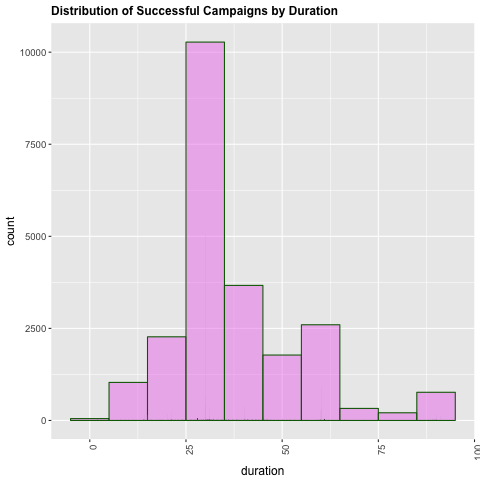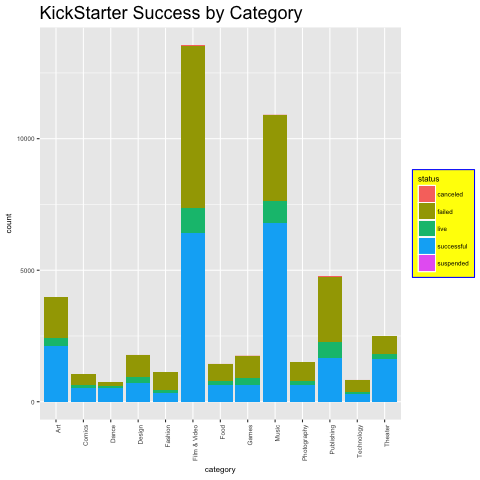Launching a Successful Kickstarter Campaign
Dance, Dance, Dance
Want to launch a successful Kickstarter campaign? Follow these tips and you are more likely to succeed than not.
Introduction
Kickstarter is a popular site for raising money for creative projects. People pitch their film or music project to the Kickstarter community, set a monetary goal and hope for the best. Sometimes the campaigns are successful, other times they are not.
I prepared this analysis in R as part of a fellowship in data science at General Assembly. The data contained information on successful and unsuccessful campaigns from 2009 to 2012, including the category of project, the timeframe, funding information, and location among other things.
Kickstarter Tip No. 1: Keep It Short
Your Kickstarter campaign should run about a month. This is because successful campaigns are on average shorter (31 days) than unsuccessful ones (42 days).
This difference in the average duration of successful and unsuccessful campaigns is statistically significant. Whether we implement a frequentist Welch’s t-test (p-value = 2.2e-16), or utilize Bayesian hypothesis test (Bayes Factor (BF[H2:H1]) = 3.054464e+280), the length of a successful campaign is not equal to the length of the unsuccessful campaign. In fact, successful campaigns are demonstrably shorter.

My advice is to use the median duration of a successful campaign as a guide – 31 days – as the data is not normally distributed and is slightly right skewed, as demonstrated by the above graph.
This is not to say that a longer duration causes campaigns to fail. As discussed below, successful campaigns typically ask for lower funding, making it easier to reach a goal in 31 days. Set a high goal, and it will be very difficult to meet your goal in 31, let alone 42 days.
Kickstarter Tip No. 2: June Is The Cruelest Month, Not April
If you are to launch a 30 day campaign, consider launching it on April 2nd or 3rd. Do not launch it in May. This is because March, April & May are the most popular months to obtain funding on Kickstarter. May is the most popular of all, and June is the least popular.
Furthermore, the first & second of the month are the most popular funding days. By launching at the beginning of April, you can take advantage of this phenomenon. By avoiding a May launch, you avoid ending your campaign in June, which is unpopular.

(May is the best month to end a Kickstarter campaign; June is the worst)
The reasons for the May/June discrepancy are beyond the musings of this post. One thought is that tax refunds put people in a more charitable mood. Another is that June is the beginning of summer and people are funding vacations over Kickstarters. I could not tease a good theory out of the data.
Kickstarter Tip No. 3: Lower Your Expectations
Successful campaigns set lower goals. A goal of $3,000 is a terrific place to start as this is the median for successful campaigns. Unsuccessful campaigns in contrast have a higher median of $5,000, with a mean of $16,351.
Kickstarter Tip No. 4: The More Levels the Better
Kickstarter allows participants to set different levels of support. Successful campaigns have a mean of eight (8) and median of seven (7) fundraising levels. The distribution is extremely right skewed, making the median a good place to set levels. Feel free to set ten (10) or more levels if you think it helps.
Kickstarter Tip No. 5: Money Loves Music, Movies, Design & Games
Film, music, design and game projects attract the most funding on Kickstarter, but launching a campaign in these areas does not guarantee success. You are more likely to win a coin toss than you are to win funding for your film project.
Our dataset contains over $50m in successful film campaigns, and over $36m in successful music projects. Though music attracts less funding than film, it has a higher rate of success at 62%. In fact, less than half of all film (47%), design (41%), & game (36%) campaigns are successful.

(Most Kickstarter campaigns are film related, though the success rate is higher for music than film. Film projects still raise more money than music projects. Notice the success rate of dance related campaigns)
Kickstarter Tip No. 6: Publish and Perish
Publishing is the third most popular Kickstarter category. Unfortunately, publishing has the second lowest success rate (35 percent). Need help publishing a book, don’t expect success on Kickstarter.
Kickstarter Tip No. 6: When in Doubt Dance
Dance is the least funded category on Kickstarter, but it has the highest success rate (69 percent). In fact, art, music, theater & dance are the only categories where over 50 percent of campaigns are successful.
Kickstarter Tip No. 8: Use Logistic Regression to Predict Campaign Success
We can build a simple algorithm that predicts the potential success of a Kickstarter campaign with 68 percent accuracy.
The model uses logistic regression and assesses the probability of whether whether a campaign will successful or not.
We can train a decent model on the following variables: 1. The category and subcategory of the campaign; 2. The funding goal; 3. The number of fundraising levels; 4. The duration of the campaign; 5. The day the campaign succeeded; and 6.The month the campaign achieved succeeded.

(R code for logistic regression model. This model performed with 68 percent accuracy on a test set)
Let’s put our model to the test on actual Kickstarter campaigns. I arbitrarily selected two campaigns: Love Found, a dance project; and Renegade Repos, a web show.
Love Found
Love Found is an example of a project with a high probability of success. It is dance related, and dance always has a high probability of success. The campaign is 30 days in length and sets a reasonable goal of $6,000, with 13 fundraising levels. If you will recall, at least eight levels is preferable.

Our algorithm tells us that Love Found has a 85 percent probability of success. It would have had an even higher probability of success (94 percent) had it ended in May, and set a goal of $3,000 with more levels.
Renegade Repo is an example of a project with a low probability of success. The campaign has features typical of unsuccessful Kickstarters: 1. It is longer than a successful campaign (45 days); 2. It is a video project (videos fail more often than not); 3. The fundraising goal is high at $65,000; and 4. It sets fewer than eight fundraising levels.

Our algorithm tells us that Renegade Repo has a 3.7 percent probability of success. Renegade Repo would have 94 percent probability of success if it: 1. Lowered its goal to $3,000; 2. Increased its number of fundraising levels; 3. Lowered its duration to 30 days; and 4. Ended the campaign in early May.
Modeling Risks
There are a few risks associated with our dataset.
While our Kickstarter prediction model is accurate on a test set, it is not without its risks. The model sees little downside to increasing the funding levels. If one predicts a campaign and adds 30 funding levels, the model increasing the probability of success. The reality is that dozens of funding levels probably add clutter and confusion to a campaign.
Moreover, the model trained on data from 2009-2011. Tastes can change every few years. So can website demographics. The model does not account for potential changes in taste and traffic. To address this risk, we will need more data.